Page 205 of 498
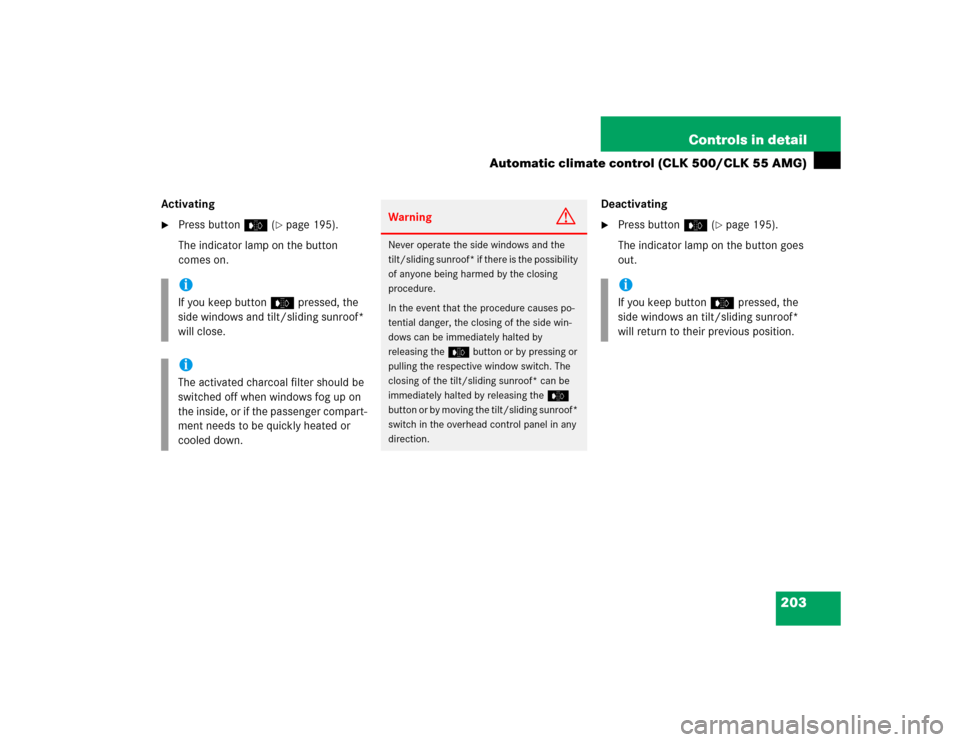
203 Controls in detail
Automatic climate control (CLK 500/CLK 55 AMG)
Activating�
Press buttone (
�page 195).
The indicator lamp on the button
comes on.Deactivating
�
Press buttone (
�page 195).
The indicator lamp on the button goes
out.
iIf you keep buttone pressed, the
side windows and tilt/sliding sunroof*
will close.iThe activated charcoal filter should be
switched off when windows fog up on
the inside, or if the passenger compart-
ment needs to be quickly heated or
cooled down.
Warning
G
Never operate the side windows and the
tilt/sliding sunroof* if there is the possibility
of anyone being harmed by the closing
procedure.
In the event that the procedure causes po-
tential danger, the closing of the side win-
dows can be immediately halted by
releasing thee button or by pressing or
pulling the respective window switch. The
closing of the tilt/sliding sunroof* can be
immediately halted by releasing thee
button or by moving the tilt/sliding sunroof*
switch in the overhead control panel in any
direction.
iIf you keep buttone pressed, the
side windows an tilt/sliding sunroof*
will return to their previous position.
Page 206 of 498
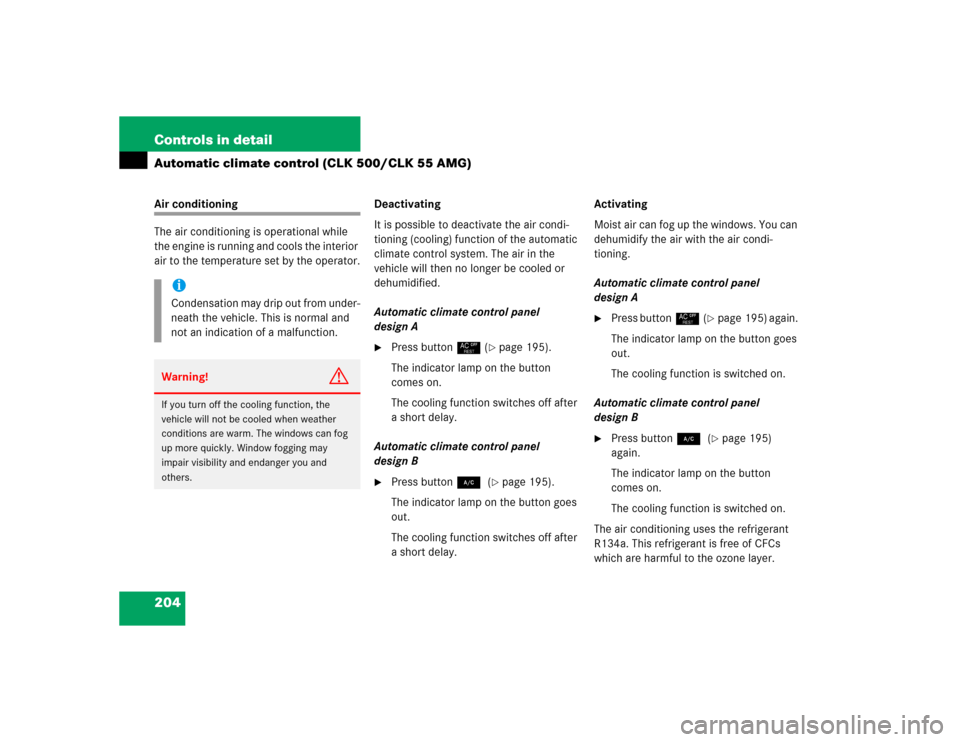
204 Controls in detailAutomatic climate control (CLK 500/CLK 55 AMG)Air conditioning
The air conditioning is operational while
the engine is running and cools the interior
air to the temperature set by the operator.Deactivating
It is possible to deactivate the air condi-
tioning (cooling) function of the automatic
climate control system. The air in the
vehicle will then no longer be cooled or
dehumidified.
Automatic climate control panel
design A
�
Press button° (
�page 195).
The indicator lamp on the button
comes on.
The cooling function switches off after
a short delay.
Automatic climate control panel
design B
�
Press button2(
�page 195).
The indicator lamp on the button goes
out.
The cooling function switches off after
a short delay.Activating
Moist air can fog up the windows. You can
dehumidify the air with the air condi-
tioning.
Automatic climate control panel
design A
�
Press button°(
�page 195) again.
The indicator lamp on the button goes
out.
The cooling function is switched on.
Automatic climate control panel
design B
�
Press button2(
�page 195)
again.
The indicator lamp on the button
comes on.
The cooling function is switched on.
The air conditioning uses the refrigerant
R134a. This refrigerant is free of CFCs
which are harmful to the ozone layer.
iCondensation may drip out from under-
neath the vehicle. This is normal and
not an indication of a malfunction.Warning!
G
If you turn off the cooling function, the
vehicle will not be cooled when weather
conditions are warm. The windows can fog
up more quickly. Window fogging may
impair visibility and endanger you and
others.
Page 207 of 498
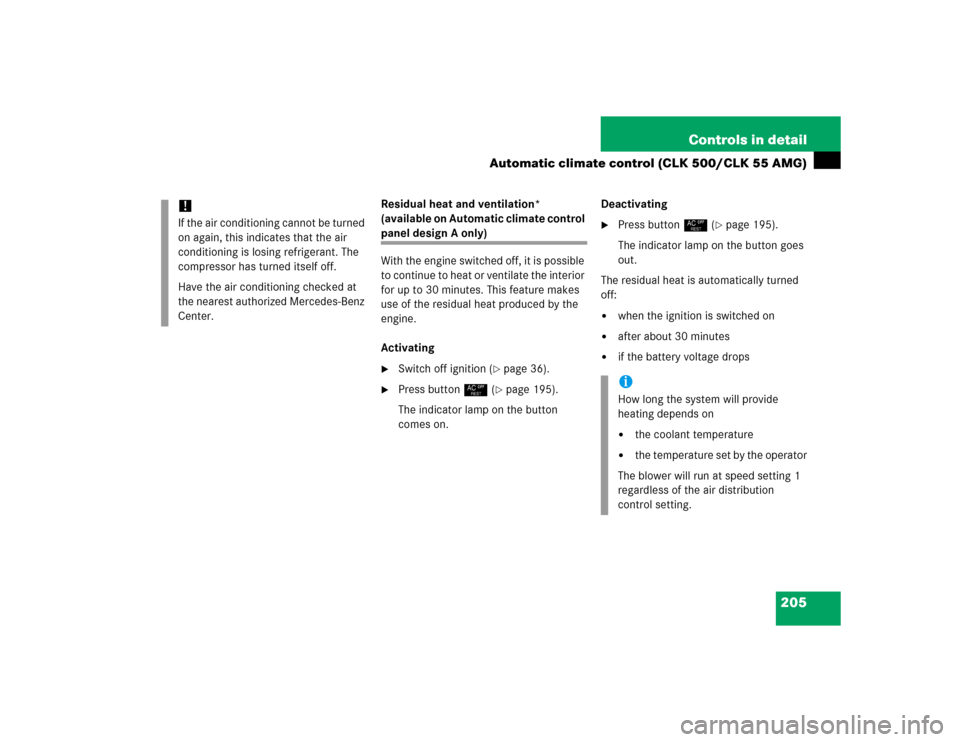
205 Controls in detail
Automatic climate control (CLK 500/CLK 55 AMG)
Residual heat and ventilation*
(available on Automatic climate control panel design A only)
With the engine switched off, it is possible
to continue to heat or ventilate the interior
for up to 30 minutes. This feature makes
use of the residual heat produced by the
engine.
Activating�
Switch off ignition (
�page 36).
�
Press button°(
�page 195).
The indicator lamp on the button
comes on.Deactivating
�
Press button°(
�page 195).
The indicator lamp on the button goes
out.
The residual heat is automatically turned
off:
�
when the ignition is switched on
�
after about 30 minutes
�
if the battery voltage drops
!If the air conditioning cannot be turned
on again, this indicates that the air
conditioning is losing refrigerant. The
compressor has turned itself off.
Have the air conditioning checked at
the nearest authorized Mercedes-Benz
Center.
iHow long the system will provide
heating depends on�
the coolant temperature
�
the temperature set by the operator
The blower will run at speed setting 1
regardless of the air distribution
control setting.
Page 208 of 498
206 Controls in detailAutomatic climate control (CLK 500/CLK 55 AMG)Rear passenger compartment adjustable air vents
The air conditioning for the rear passenger
compartment is controlled via the auto-
matic climate control panel (
�page 195).The air vents for the rear passenger
compartment are located in the rear
center console.
1Thumbwheel for air volume control for
center air vents
2Left center air vent
3Right center air ventAdjusting air distribution
�
Push the slide for the left center
vent2 or right center vent3 to the
left, right, up or down.
The air flow is directed in the corre-
sponding direction.
Adjusting air volume
�
Turn thumbwheel1 t o t he l e f t o r r i g h t .
The air volume is increased or de-
creased.
iThe temperature at the center air vents
for the rear passenger
compartment2 and3 i s t h e s a m e a s
at the dashboard center air vents.
iFor draft-free ventilation, push
slides2 and3 upward.
Page 250 of 498
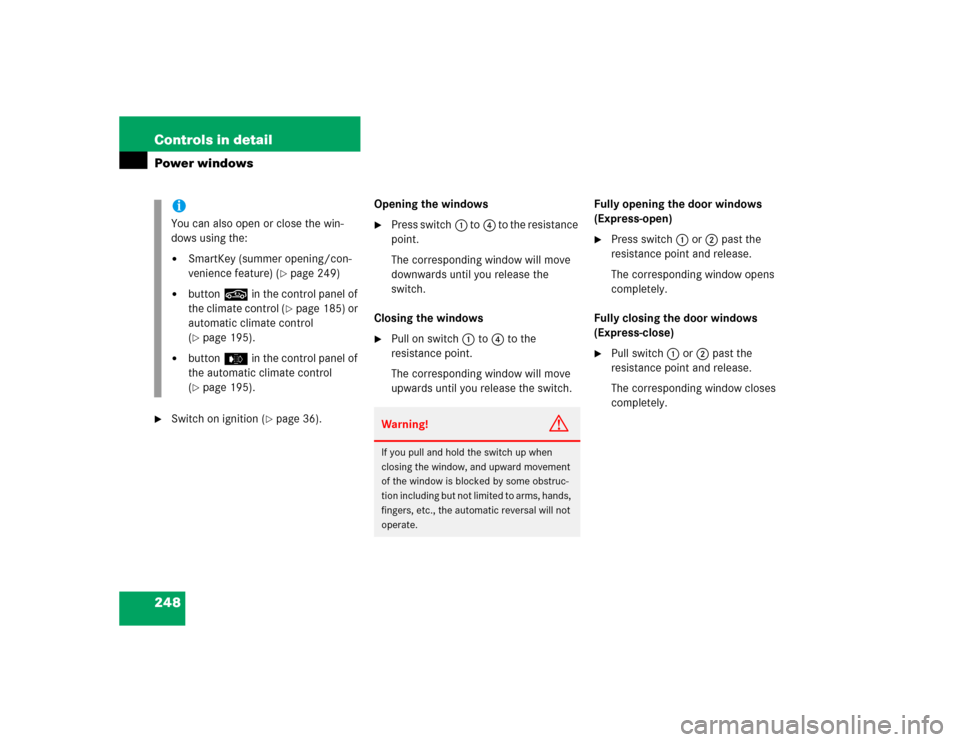
248 Controls in detailPower windows�
Switch on ignition (
�page 36).Opening the windows
�
Press switch1 to4 to the resistance
point.
The corresponding window will move
downwards until you release the
switch.
Closing the windows
�
Pull on switch1 to4 to the
resistance point.
The corresponding window will move
upwards until you release the switch.Fully opening the door windows
(Express-open)
�
Press switch1 or2 past the
resistance point and release.
The corresponding window opens
completely.
Fully closing the door windows
(Express-close)
�
Pull switch1 or2 past the
resistance point and release.
The corresponding window closes
completely.
iYou can also open or close the win-
dows using the:�
SmartKey (summer opening/con-
venience feature) (
�page 249)
�
button, in the control panel of
the climate control (
�page 185) or
automatic climate control
(
�page 195).
�
buttone in the control panel of
the automatic climate control
(�page 195).
Warning!
G
If you pull and hold the switch up when
closing the window, and upward movement
of the window is blocked by some obstruc-
tion including but not limited to arms, hands,
fingers, etc., the automatic reversal will not
operate.
Page 254 of 498
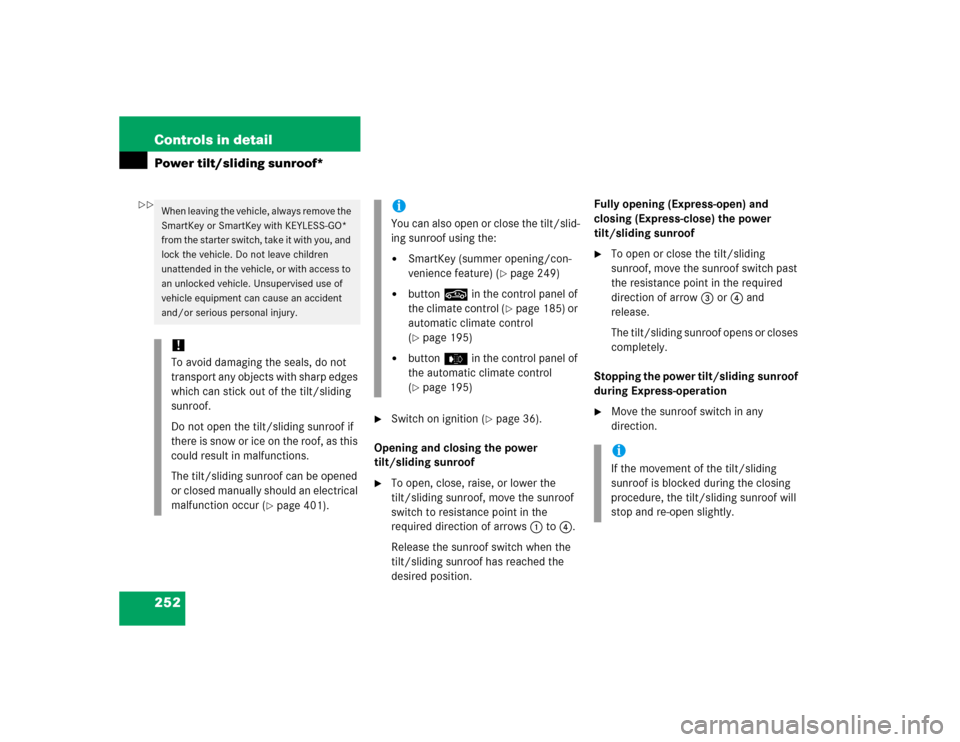
252 Controls in detailPower tilt/sliding sunroof*
�
Switch on ignition (
�page 36).
Opening and closing the power
tilt/sliding sunroof
�
To open, close, raise, or lower the
tilt/sliding sunroof, move the sunroof
switch to resistance point in the
required direction of arrows1 to4.
Release the sunroof switch when the
tilt/sliding sunroof has reached the
desired position.Fully opening (Express-open) and
closing (Express-close) the power
tilt/sliding sunroof
�
To open or close the tilt/sliding
sunroof, move the sunroof switch past
the resistance point in the required
direction of arrow3 or4 and
release.
The tilt/sliding sunroof opens or closes
completely.
Stopping the power tilt/sliding sunroof
during Express-operation
�
Move the sunroof switch in any
direction.
When leaving the vehicle, always remove the
SmartKey or SmartKey with KEYLESS-GO*
from the starter switch, take it with you, and
lock the vehicle. Do not leave children
unattended in the vehicle, or with access to
an unlocked vehicle. Unsupervised use of
vehicle equipment can cause an accident
and/or serious personal injury.!To avoid damaging the seals, do not
transport any objects with sharp edges
which can stick out of the tilt/sliding
sunroof.
Do not open the tilt/sliding sunroof if
there is snow or ice on the roof, as this
could result in malfunctions.
The tilt/sliding sunroof can be opened
or closed manually should an electrical
malfunction occur (
�page 401).
iYou can also open or close the tilt/slid-
ing sunroof using the:�
SmartKey (summer opening/con-
venience feature) (
�page 249)
�
button, in the control panel of
the climate control (
�page 185) or
automatic climate control
(
�page 195)
�
buttone in the control panel of
the automatic climate control
(�page 195)
iIf the movement of the tilt/sliding
sunroof is blocked during the closing
procedure, the tilt/sliding sunroof will
stop and re-open slightly.
��
Page 338 of 498
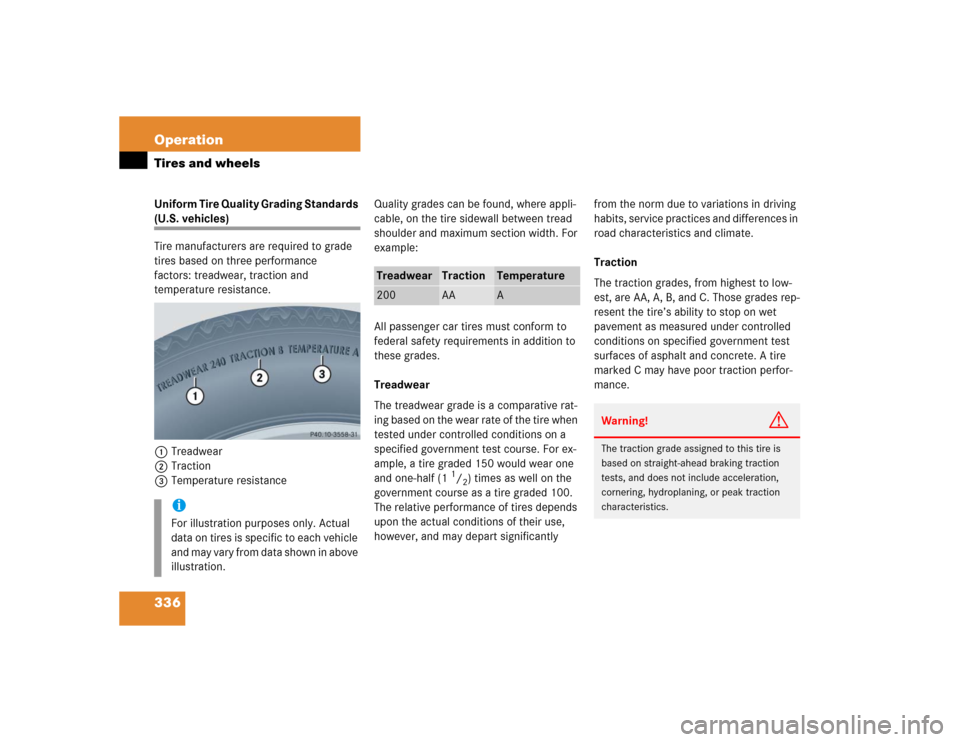
336 OperationTires and wheelsUniform Tire Quality Grading Standards (U.S. vehicles)
Tire manufacturers are required to grade
tires based on three performance
factors: treadwear, traction and
temperature resistance.
1Treadwear
2Traction
3Temperature resistanceQuality grades can be found, where appli-
cable, on the tire sidewall between tread
shoulder and maximum section width. For
example:
All passenger car tires must conform to
federal safety requirements in addition to
these grades.
Treadwear
The treadwear grade is a comparative rat-
ing based on the wear rate of the tire when
tested under controlled conditions on a
specified government test course. For ex-
ample, a tire graded 150 would wear one
and one-half (1
1/2) times as well on the
government course as a tire graded 100.
The relative performance of tires depends
upon the actual conditions of their use,
however, and may depart significantly from the norm due to variations in driving
habits, service practices and differences in
road characteristics and climate.
Traction
The traction grades, from highest to low-
est, are AA, A, B, and C. Those grades rep-
resent the tire’s ability to stop on wet
pavement as measured under controlled
conditions on specified government test
surfaces of asphalt and concrete. A tire
marked C may have poor traction perfor-
mance.
iFor illustration purposes only. Actual
data on tires is specific to each vehicle
and may vary from data shown in above
illustration.
Treadwear
Traction
Temperature
200
AA
A
Warning!
G
The traction grade assigned to this tire is
based on straight-ahead braking traction
tests, and does not include acceleration,
cornering, hydroplaning, or peak traction
characteristics.
Page 463 of 498

461 Index
A
ABS 25, 84, 455
Malfunction indicator lamp 354
Messages in display 365
Accelerator position,
automatic transmission 171
Accessory weight 338
Accident
In case of 54
Activating
Air conditioning (cooling) 192, 204
Air recirculation mode 190, 201
Anti-theft alarm system 90
Automatic climate control 195
Central locking (control system) 158
Charcoal filter 203
Climate control 185
Climate control system 187
Defrosting 189
Automatic climate control 200
Easy-entry/exit feature 159
Electric air pump 417
ESP 88Exterior headlamps 50
Exterior lamps 125
Exterior rear view
mirror parking position 180
Front and rear fog lamp 128
Hazard warning flasher 131
Headlamps 50
High beams 129
Ignition 34
Ignition with KEYLESS-GO* 36
Immobilizer 56, 89
Rear window defroster 183
Residual heat 205
Seat heating* 119
Seat ventilation* 120
Tow-away alarm 91, 92
Windshield wipers 52
Adding
Coolant 313
Engine oil 312
Additional turn signals 404
Adjustable air vents, rear
passenger compartment 193, 206Adjusting 37
Air distribution 188, 198
Air volume 199
Backrest tilt 38
Exterior rear view mirror 41
Head restraint height 38
Head restraint tilt 39
Instrument cluster illumination 134
Interior rear view mirror 41
Mirrors 41
Multicontour seat* 118
Seat cushion depth 118
Seat cushion tilt 38
Seat fore and aft adjustment 38
Seat height 38
Seats 37
Steering column in/out 41
Steering column up/down 41
Steering wheel 40
Aids for changing fuses 430